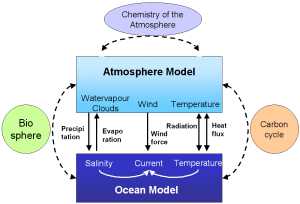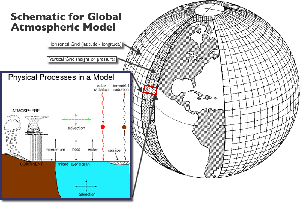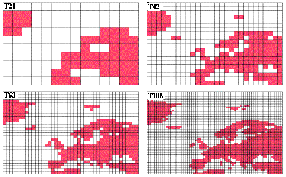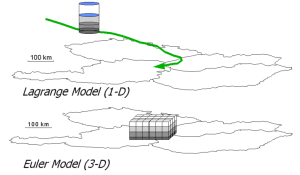|
|
 |
|
|
|
 |
 |
|
|
 |
Context: How does a climate model work?
|
Key words:
modelling, scenarios, climate parameters, grid, physical formula | |
|
 Introduction Introduction
The way we live at present will determine the world's climate over the coming decades and centuries. Therefore, how we treat our environment today is highly relevant for the life of our children and subsequent generations. In geography classes you learn about climate maps which are drawn following a classification according to Troll and Paffen or Koeppen. But you can be rather sure that the climate map of your grandchildren in 2060 will clearly deviate from the map you have in your schoolbook. Humans change nature with a speed we never experienced before.
|
 What is a climate model? What is a climate model?
Temperature and rain, floods and storms, droughts and cold spells determine our life to a significant extent. We would like to know how we change the Earth's climate but we cannot carry out laboratory experiments for this purpose because the Earth's system is too complex to be simulated in a reactor. Governments and citizens ask climate scientists to estimate how the climate could be like in 50 or 100 years.
A climate model is a computer based version of the Earth system, which represents physical laws and chemical interactions in the best possible way. We include the sub-systems of the Earth system, which is gained from investigations in the laboratory and measurements in reality.
|
 |
 |
 |
|
1. The 20th century in 80 seconds: In order to understand the challenge of estimating the climate changes up to 2100, imagine you lived in the year 1903 and you should foresee what happens in the world until 2001 ...
Here you see a short clip of events from the last century (300 KB animation). Please click the animation for a larger version. (1.3 MB!)
|
|
 |
 |
|
2. Scheme of a coupled atmosphere ocean model and supplementary models. Scheme derived from Hamburg educational server.
Please click the scheme for a larger version. (40 KB)
|
|
 |
A global model is composed of data derived from the results of models simulating parts of the Earth system (like the carbon cycle or models of atmospheric chemistry) or, if possible with the available computer capacity, the models are directly coupled. The functionality of the models is tested by comparing simulations of the past climate with measured data we already have.
 What are scenarios? What are scenarios?
Climate scientists calculate the future changes of the climate system with different models based on so called "scenarios". A scenario is an estimation of future greenhouse gas and aerosol emission changes under certain assumptions. Since we do not know how our world will develop in policy, society, technology and economy we need to assume numerous options. The IPCC scenario families A2, A1 and B1 have been described in the "research" part of this magazine.
|
|
 The climate factors The climate factors
A climate model is based on a system of equations comparable to a weather forecast model. Meteorological parameters like wind, water vapour, energy exchange and continuity in the total mass within the modelled system have to be described in equations and to be coupled.
However, a climate model will not predict the weather for March, 22nd 2067 based on data from March 21st 2067. It will only estimate the likelihood for certain weather patterns. For example, in the period 2080 - 2100 we can expect 40% less winter rain in a certain region than today. Therefore, there are clear differences between climate and weather models.
Other factors, changing in the mid term, have to be considered: greenhouse gases and aerosols change the energy balance of the Earth. With increasing warming of the planet the air can hold more water on average. In many regions evaporation and precipitation will increase. Today's models include the greenhouse gases responsible for global warming (carbon dioxide, methane, nitrous oxide, CFCs and ozone) as well as emissions of sulphur gases and air pollution, which have a cooling influence.
|
|
 From the physics of the Earth system to the mathematics of the model From the physics of the Earth system to the mathematics of the model
It is not possible to describe all physical interactions considered in the climate system model in detail on this website. Here you can click a few of the basic equations and laws which are either used in three dimensional numerical models or needed to understand the equations used. Maybe you know some of them from your physics classes, others are rather complicated. If you are interested in the mathematics you can follow the links to the descriptions in Wikipedia.
|
|
|
 |
Click the equation and I'll tell you what's behind it!
(some explanations appear in a new window - just close it after reading) |
|
Equations like these or derived from these have to be coupled in a climate model ... and many many more. The climate factors we are changing (like greenhouse gases) also have to be included. For this read the text "Simple Models".
You saw only a few examples of major equations. Click on the following link if you would like to get a better idea of which equations climate modellers work with (also these are still the simple ones).
University of Reading "The primitive equations"
 The gridded Earth The gridded Earth
Certainly we know, that the weather and physical conditions are not the same everywhere on Earth.
|
In the tropics, solar insolation and temperature are much higher than at the North pole. Evaporation and precipitation can be stronger, since warmer air holds more water than cold air. But even for the same latitude the climate can vary significantly depending on the properties of the Earth's surface. Over the Himalayas, atmospheric conditions are completely different from the Shanghai region.
|
 |
 |
 |
|
6. Elevation map: Himalaya and East China basin
For the full map please click on the image! (80 KB)
|
|
 |
 |
|
7. Grid and parameters in a global atmospheric model © NOAA
Please click the image for a larger version! (100 KB)
|
|
 |
We also know that more gases and particles emitted by humans are released to the air over the densely populated regions in Europe, North America and Asia than over the ocean. We cannot just put the Earth into a model like a cake into the oven. We need to divide up the air and oceans in the horizontal and vertical and calculate the state of the atmosphere (wind, temperature, etc.) and the oceans in little grid cells or boxes.
Typical global models have a horizontal resolution of 250 km and a vertical resolution of 1 km, newer versions even finer. The horizontal resolution of a typical ocean model is 125 - 250 km and the vertical resolution 200 - 400 m. In the vertical the atmosphere is, for example, split into about 20 layers, reaching an altitude of about 30 km.
|
The layers in ocean models go as deep as 5000 m, i.e. to the deep sea floor. Small scale physical processes which are below the size of the grid cells cannot be explicitly resolved. Their net impact on the coarse scale processes is estimated and included into the model by parameterisation. In the atmosphere this is in particular the case for cloud formation, in the ocean for small scale eddies and for convection processes.
|
 |
 |
 |
|
8. Europe in different grid resolutions © Hamburger Bildungsserver
Click the image for a better resolution! (55 KB)
|
|
 |
 |
|
9. Langrangian and Eulerian model © Werner Winiwarter
|
|
 |
The equations are set up in order to model the dynamics at the grid points. If atmospheric chemistry is modelled, the reactions are often taking place over a certain time in an air parcel. Although fixed grid models take into account horizontal movements, too, it can be more convenient to simulate the reactions in a moving air parcel. We call such models lagrangian models in contrast to fixed grid eulerian models. But lagrangian models are not applicable for climate modelling.
|
|
The quality of the results of such models in simulating the future climate depends also on the resolution of the grid. The finer, the better. This in turn depends on the available capacity of the computer. The biggest computers in the world are used for climate modelling and fortunately their capacity is increasing. So, more detailed calculations can be carried out for each future report of the IPCC.
|
 |
 |
|
10. The development of climate models over the last 25 years showing how the different components are first developed separately and later coupled into comprehensive climate models. © IPCC TAR 2001 Technical summary, Box 3, Fig 1
|
Author:
Elmar Uherek - Max Planck Institute for Chemistry, Mainz
Reviewer:
.
English check: Mark Jacob, TU Freiberg
|
|
 |
|







